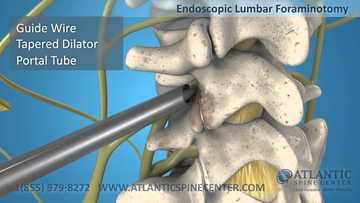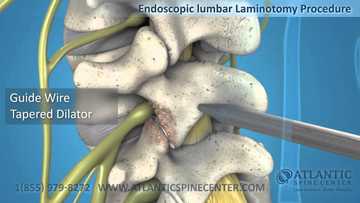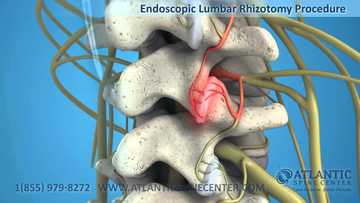Endoscopic Spine Surgery
Diagnostic Procedures
Pain Management Procedures
Traditional Spine Fusion Surgeries
Mini Spine Fusion and Spine Disc Replacement
Endoscopic Spine Surgery
Endoscopic Spine Surgery is a type of state-of-the-art surgery that uses small tubular systems or micro incisions, assisted with an endoscope for visualization. This type of Minimally-Invasive Spine Surgery (MISS) provides patients with quicker recovery and less pain than traditional spine surgery.
As there are over 1.5 million spinal procedures per year in the US, minimizing the healing time and pain are the main goals of making a recovery more efficient in such a huge number of patients. Endoscopic spine surgery offers better recovery and fewer complications.
multimedia
What is endoscopic spine surgery?
Endoscopic spine surgery is a type of state-of-the-art surgery that uses a small tubular system or micro incisions, assisted with an endoscope for visualization. An HD camera is attached to the endoscope to provide the surgeon with good visualization to operate using micro-tools like graspers, lasers, or radiofrequency probes. This type of minimally-invasive spine surgery (MISS) provides patients with quicker recovery and less pain than traditional spine surgery. The goal of the surgery is to find the source or generator of pain in the spine. This procedure is much safer, more accurate and has better outcomes for the patients in comparison with some other scoliosis surgery types. Endoscopic spine surgery also preserves the range of spine mobility after the surgery.
Our endoscopic spine surgery is a true minimally invasive procedure that has revolutionized the treatment of chronic back and neck pain, as well as leg pain. If you're searching for long lasting pain relief, we can help.
Endoscopic spine surgery helps those who suffer from back pain. This scoliosis surgery can treat several conditions, including sciatica, bulging or herniated discs, spinal stenosis, as well as foraminal stenosis, facet joint syndrome, chronic low back pain, failed back surgery syndrome, disc tears, and degenerative disc disease.
Usually, people diagnosed with some of the mentioned conditions are offered non-invasive treatment options first. They can also fail the epidural blocks procedure. But then, if conservative treatments didn’t relieve the pain, the patient can become a candidate for endoscopic spine surgery.
To be considered a candidate for endoscopic spine surgery, a person should have leg pain and some unpleasant sensations such as numbness or tingling, the pain can be worse after bending. The symptoms should last for 4-6 weeks even after conservative treatments, rest and physical therapy. Also, a patient should have diagnosing tests like MRI, CT scan, CT myelogram, or discogram showing a disc herniation.
In most cases, there's no need to worry about how to prepare for endoscopic spine surgery, as the majority of patients don’t need a special preparation period. But your doctor can advise you on how to prepare for spine surgery. For example, losing excess weight can relieve pressure on the spine and speed recovery. Incorporating healthy habits and quitting bad ones, like smoking, are also great ways to prepare for scoliosis surgery. Probably, the most important tips are to plan time off work so that you could relax during the recovery period and avoid blood thinning medications before the surgery.
There are several types of endoscopic surgery. The first one is a posterolateral or interlaminar approach. During this procedure, a small incision is made to access the lamina to get access to the spine. This type of surgery offers a broad application, which is especially beneficial as many disorders include neural compression. The second approach is extraforaminal or transforaminal. This approach is used to get access to isolated unilateral foraminal conditions and neural compression. Although, in this type of surgery, there’s a limited capacity.
Typically, the procedure starts with local anesthesia or sedation. Then your surgeon makes small skin incisions of 5-6 mm. The next surgery step is the insertion of an endoscope through the incisions. Using an X-ray to control, the endoscope is moved to the source of pain. Then some tissue of a herniated disc can be removed to relieve the pain. This is usually the end of this procedure.
The success rate of endoscopic spine surgery depends on many factors. If a patient has a relatively straightforward problem that's seen on MRI and determined on a physical exam, there should be a good success rate. But if the case is more challenging or the person has a slower tissue recovery speed, the success rate can be slower and the healing time can be prolonged. Usually, the approximate success rate of the procedure is discussed with a doctor before a person has the surgery. Your medical team can help you assess your health, the state of the condition, and some other factors and choose the most appropriate treatment plan.
What are the benefits of endoscopic spine surgery?
The main goal of endoscopic spine surgery is to ease back pain, avoid spinal fusions, and preserve spinal mobility. There are many benefits of this procedure. Some advantages of our industry-leading minimally invasive endoscopic and fusion alternative surgeries include the following:
- Microscopic incision
- Using a camera
- Lower risk of infections
- Avoiding general anesthesia
- Minimal or no blood loss
- Immediate recovery
- Less post-operative pain
- Reduced pain meds
- Preservation of spinal mobility
- Same day surgery
- Reduced scarring
- Lower chance of tissue tearing
- High success rates
- Sooner return to normal activities
- Improved quality of life
To sum up, smaller incisions allow less trauma to skin and muscle tissue, which reduces blood loss and speeds spinal stenosis surgery recovery. A patient can go home the same day after the surgery.
As the surgery typically doesn’t require a hospital stay, you’ll be able to go home within hours after the procedure. Even before that, it can be advised to get up and walk around. Within a week or two, a patient is able to go back to work, and getting back to all their normal activities and physical pursuits should take only a few additional weeks. So, all in all, the spinal stenosis surgery recovery can last for 1-2 weeks, or even less.
The recovery is very fast, but a patient shouldn’t bend, twist or lift things for a while.
What are the risks of endoscopic spine surgery?
Even though there are many advantages of endoscopic spine surgery, the procedure still is associated with some risks.
This technique is relatively new, so some disadvantages of the surgery are caused by this factor. Firstly, clinical research is still rather limited and the long-term results of the procedure are also less studied. As the training for this type of surgery is not yet included in the standard training program for spine surgeons, there’s a need to find a well-qualified and experienced specialist.




